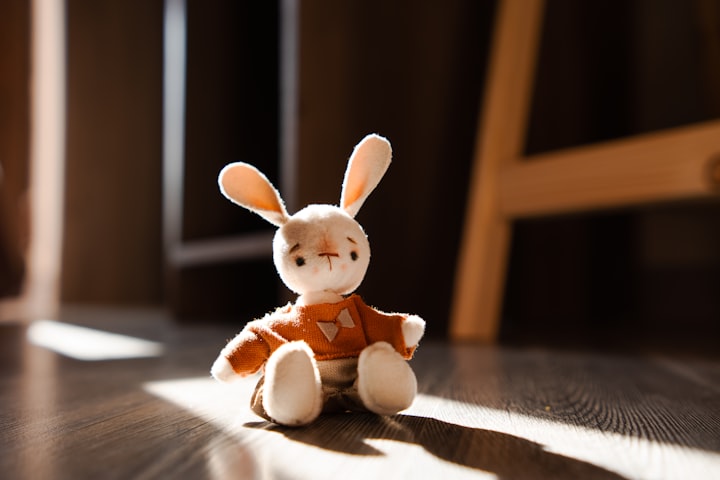When Hitler Stole Pink Rabbit
A children's book about the Nazis

I still remember the day I got the dark circles around my eyes. I don’t know how it came into my possession, but I had a torch. One night when my dad said it was time to close my latest Goosebumps and turn the light off, I did as he said. Then, listening carefully until I was sure he was at the bottom of the stairs, I picked up my book again, pulled the torch out from under my pillow and carried on reading.
When I woke up in the morning, I looked in the mirror and gasped when I saw the big purple shadows around my eyes. Oh no! My parents would definitely know I had stayed up late! The dark circles never went away (to this day) but the silver lining was that after that first morning, my parents never knew which nights I had stayed awake far too late reading.
I never understood why people used to read stories to children to get them to fall asleep. They did the exact opposite for me: after reading a book I was wide awake, mind racing and imagination firing. I was always desperate to know what happened in the next chapter and simply could not put the book down until tomorrow night. Before the torch, when I was forced to put the book down, I’d simply continue the stories in my head. I went to Hogwarts with Harry, rode in the Giant Peach with James, solved mysteries with Nancy.
When Hitler Stole Pink Rabbit by Judith Kerr was a book I stayed up late with time and time again. I remember reading it with my little cuddly elephant tucked into the crook of one arm so she could see the page too, and promising that I would never let Hitler steal her. The book is aimed at children and written through the eyes of a nine-year-old girl, but it is really a story for all ages. Indeed, I used to come back to it every few years, and with each new read would see it in a fresh light.
The novel follows Anna, a young Jewish German whose father disappears in the dead of night. The next evening, she finds herself packing a suitcase for her own escape and is told she can only take one toy. She opts for a new floppy dog, leaving old favourite Pink Rabbit behind, a decision she will come to regret when she starts to imagine Hitler carrying Pink Rabbit around with him.
Anna is not quite sure who Hitler is, though she has seen pictures of him on posters, but for some reason Hitler doesn’t like Anna. It is the eve of the 1933 elections, and Anna’s family flees Germany for neighbouring Switzerland. The rest of the story follows them as they try to make a new life as refugees, first in Zurich, then Paris, and finally London.
This story has special meaning for me because it was the first book that made me cry. It was the first book to make me feel true empathy for another person and to see the challenges of life through another’s eyes. It was the first book to interest me in history and politics, and to understand their impact on an innocent child’s life.
It also set me on a lifelong path of language-learning, because I was moved by Anna’s struggle to learn French and fit into a new country, and I was in awe of the fact that she ended up knowing German, French and English. Today I speak French and Spanish fluently and have spent several years living in Germany, France and Spain on my very own migration around Europe.
When Hitler Stole Pink Rabbit captured my imagination when I was a child because it is written from a child’s perspective. Many fantastic books have been written for children, but not all of them actually feel like a child is telling you the story. In this book, I stepped into Anna’s shoes and felt what she felt. Through Anna’s eyes, I saw her journey across Europe as a thrilling adventure, difficult at times, but always exciting.
This book inspired me to imagine how I would feel if I were forced to flee my own country, leave everything behind and start life over again. It made me consider what it would be like to live in a new country, learn a new language and make new friends. It pushed me to think about how I would be brave for my family when faced with difficult circumstances.
The subject matter is an unusual one for a children’s book, but there comes a time when we must realise that life is not all magic and fairytales. The novel is a good introduction to a challenging topic and a difficult period in history without ever dwelling on it. Hitler’s rise to power is the background, but the focus of the novel is on Anna’s family and their experience building a new life abroad. It is hopeful and positive and funny, and teaches us that there is light and laughter even in the dark times.
When I first read this book, like Anna, I didn’t really know who Hitler was or why he hated Anna and her family. I just knew he was a bad man who had forced Anna to leave all her friends behind and had stolen Pink Rabbit! As a teenager, I read the story with new eyes, then having the knowledge about what happened in Germany during that period.
And when I was older, it grew even more poignant as I identified with the adults in the novel, Anna’s parents, and realised how much they must have suffered, how afraid they must have been, and how well they protected her from their fear, as well as from the horrors of Nazi Germany. Reading it after The Diary of Anne Frank is particularly devastating, when you realize just how different Anna’s story could have been.
Despite being set nearly 90 years ago, the novel’s themes are timeless and still relevant today. Sadly, war and conflict, authoritarian regimes, racism, anti-Semitism and refugees are still a part of our world. This book is so important and its themes so vital for children to read and understand, because it encourages us to see refugees not as the other, but as a person the same as we are.
Anna is just like any other child in any country she passes through – all she wants is to go to school, have fun, make friends and spend time with her family. This book asked me to imagine myself in that situation, inspired me to empathise with others and, most of all, it taught me not to judge anybody for their religion or ethnicity.
*Adapted from a previous Vocal story.
About the Creator
Jenifer Nim
I’ve got a head full of stories and a hard drive full of photos; I thought it was time to start putting them somewhere.
I haven’t written anything for many, many years. Please be kind! 🙏






Comments
There are no comments for this story
Be the first to respond and start the conversation.